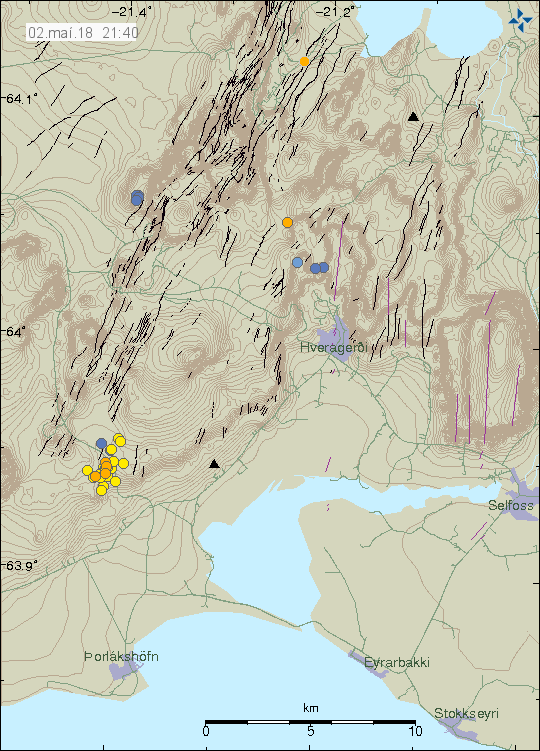Since yesterday (01-Maí-2018) has been a minor earthquake swarm in Hengill volcano in area of Raufarhólshellir cave. Largest earthquake had a magnitude of 2,9 (at 03:46 UTC) and all other earthquakes that happened were smaller in magnitude. Most common magnitude was 0,3 but few magnitude 1,0 earthquake also happened.

The earthquake swarm in Hengill volcano. Copyright of this image belongs to Icelandic Met Office.
This earthquake swarm seems to be in a location that might had a dike injection in the years 1995 – 1998 (I don’t have older data). Data from 1995 and until today can be viewed here (this website is in Icelandic). Since 2000 SISZ earthquakes this area has been quiet and I guess this area is mostly going to be quiet besides this minor earthquake swarms that are currently happening.
Donations
Please remember to support my work. Currently I am having problem with paying all the bills in Denmark since they come in three month cycle. The good news is that this is the last time I have to deal with this issue since I am moving away from Denmark at the end of the month. Thanks for the support. 🙂
Article updated at 23:18 UTC. Minor year fixes.

Hi Jon,
Good to be back here again.
I notice quite large quakes on the Reykjanes Ridge and towards Jan Mayen Island. These straddle the fault which runs through Iceland, presumably Iceland will be seeing higher stress as a result?
All the best,
mike
The activity at Jan Mayen is not connected to Iceland. As there is a lateral fault (west-east) that connects to the fault area from Bárðarbunga volcano or eastern volcano zone in Iceland.
The Reykjanes rift zone only goes to Hveravellir and ends there.
Sorry, in my ignorance I was looking at the usgs representation, which links these areas on a single fault line.
mike
That is the common image. But it is wrong. The fault zone that goes trough Hveravellir ends there. Hofsjökull glacier is on its own rift zone. The easter rift zone is a new rift zone that is now extending south of Vestmannaeyjar. That means it is growing in that direction and is going to so over the next few million years.
Looks like the Oraefajokull volcano has been dropped down from Yellow to Green
It is my view that Icelandic Met Office is making a mistake by doing so. The risk of an eruption has not passed. Far from it. The thing is that event in Öræfajökull volcano move slowly and this is going to take few more moths until an eruption happens. But it is my view that it is going to happen.
What time frame do you reckon we could be seeing a possible eruption if the activity continues the way it is?
At the moment I am estimating a period of 6 to 18 months. But due to how unstable the process seems to be I am re-estimating this timeframe all the time. As I get more data the better picture I get of what is going on in Öræfajökull volcano.
You might say the “moths” are between their ears? So this is kind of giving everyone the idea that its all but finished, which I agree is not the case.
There are smart people working at Icelandic Met Office and elsewhere. But this is in my view a problem of culture. The thinking has been due to random factors that happened in the past that Icelandic volcanoes erupt fast and always big.
That was the reason why the debate started of the minor eruption in Katla and Hamarinn in July 2011. Even if the tremor signal and the glacier floods that followed in both cases was a clear giveaway on what happened.
Now it is Öræfajökull volcano turn to break all the rules. It is doing something that doesn’t happen often in Iceland. It is slow moving and it is breaking all the “rules” they teach in Iceland. I am not educated in Icelandic school on geology (at professional levels) so I don’t hold those views that new geologies are learning in Icelandic schools today.
The thinking seems to be that Öræfajökull volcano was going to erupt quickly and fast as any other volcano in Iceland after the micro-earthquake swarm activity started. That is not something I am expecting, at least not for now. That is going to happen in the end, but other issues might happen until then.
There is going to be ongoing micro-earthquake activity in Öræfajökull volcano. With increased hydrothermal activity in the top crater as this moves closer to an eruption. Magnitude of earthquakes is going to increase in the final phase just before the eruption happens. When and how long this all takes I do not know yet.
So did Katla erupt in 2011?
Yes, but that eruption was a minor and only lasted 10 – 20 hours at most.
Eyjafjallajokull also was slow moving. It took 11 years after the 1999 intrusion and 3 months of swarms before the first eruption in March 2010.
I think too that Oraefajokull will eruption in soon. Might took a few months or a decade in the slower scenario.
I think Öræfajökull eruption will be slow and long and probably one of the greatest eruptions in the modern history of Europe.
I mean it is going to be stronger than Eyjafjallajökull and to last longer. Öræfajökull has already had an eruption in the history and it was the greatest volcanic eruption in all neolith, causing Ireland, Norway and Greenland to suffer causalities of it, while Iceland has lost 3/4 of its population due to famine caused by it.
Jötunn is confusing Öræfajökull with Laki eruption. Possibly also Eldgjá (Katla) eruption.
aah yes it was Katla
so this one is going to be Ragnarök then :Ð
Øræfa is responding to the downgrading. A lot of small eq. Its always in swarms